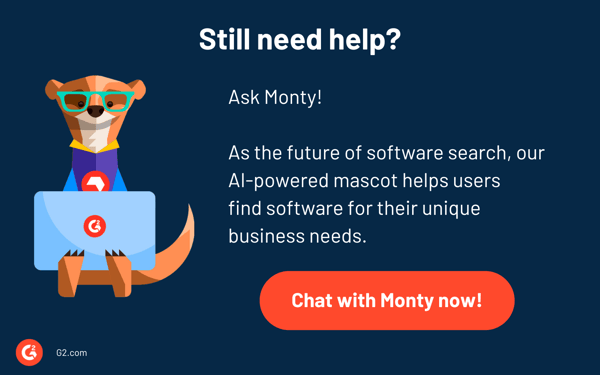September 22, 2025
 by Hannah Harrington / September 22, 2025
by Hannah Harrington / September 22, 2025

Imagine if every visitor who discovered your website turned into a paying customer.
In reality, even the best marketing funnels, well-researched buyer personas, and conversion-optimized websites can’t guarantee that outcome. The modern buyer’s journey is nonlinear, filled with distractions, competing options, and shifting intent.
That’s where retargeting comes in.
Retargeting is a digital advertising strategy that re-engages people who’ve already interacted with your brand, whether they visited your site, clicked an ad, or abandoned their cart. It uses tracking tools, such as cookies or pixels, to capture past activity and deliver personalized ads across platforms like Google, Facebook, and LinkedIn.
Most visitors don’t convert the first time they land on your site, and that’s okay. Retargeting software gives you a second chance to reach them.
In a crowded digital landscape, retargeting helps bridge the gap between interest and conversion, turning missed opportunities into measurable results.
Though often used interchangeably, retargeting and remarketing serve distinct purposes in digital marketing.
Remarketing focuses on re-engaging people who already know your brand, past customers, email subscribers, or app users, through owned channels like email, push notifications, or in-app messages. It’s about nurturing relationships, driving repeat business, and boosting loyalty.
Example: Sending a personalized discount email to a customer who hasn’t made a purchase in 60 days.
Retargeting, on the other hand, targets new visitors who haven’t yet converted. It uses paid ads across platforms like Google, Facebook, and LinkedIn to bring them back after they’ve shown interest by viewing a page or abandoning a cart.
Example: Showing display ads featuring the exact product a shopper viewed but didn’t buy.
| Aspect | Remarketing | Retargeting |
| Goal | Reconnect with existing customers | Re-engage unconverted visitors |
| Channels | Email, app, website messages | Display, social, and search ads |
| Audience | Known contacts | Anonymous site visitors |
| Focus | Retention and loyalty | Conversion and acquisition |
The best marketing strategies combine both, use remarketing to strengthen existing relationships and retargeting to convert new leads, ensuring you stay visible at every stage of the buyer journey.
Retargeting utilizes tracking tools to identify users who’ve interacted with your site or ads, enabling marketers to re-engage them through targeted advertising.

Source: ReTargeter
The most common method is pixel-based retargeting, which works by embedding a small piece of JavaScript code, often referred to as a tracking pixel, on your website.
When a visitor lands on your site, this pixel stores a browser cookie that records behavioral data, such as the pages they view, products they explore, or items they add to their cart.
Once the visitor leaves, ad networks like Google Display Network, Meta Ads, or LinkedIn Ads use that cookie to show targeted ads to the same user as they browse other sites or social media platforms. This ensures your brand stays visible during key decision-making moments.
A more advanced form, known as dynamic retargeting, customizes ad content based on the exact products or services a user viewed, automatically pulling images, prices, and offers from your product catalog.
Meanwhile, list-based retargeting uses data from your CRM or marketing automation tools to re-engage known audiences (like previous buyers or email subscribers) through ads on search and social networks.
To execute and optimize these campaigns, marketers often rely on customer data platforms (CDPs) that unify audience data for better precision. Together, these tools create a powerful ecosystem for capturing user intent, improving ad relevance, and driving conversions more efficiently.
Now that we’ve covered the basics of retargeting, let's discuss how it can align with your current marketing efforts. Although it is theoretically simple, it can take time to fully develop a well-thought-out retargeting strategy.
Here are some options to get you on your way:
Google’s Ad Network works with some of the most highly trafficked sites at a much more affordable price than working directly with the site (i.e., Mashable or BuzzFeed).
Through a Google AdWords campaign, you can retarget visitors with ads that show the products they viewed on your website.
For example, take a look at these two ads retargeted to me on BuzzFeed News.

You can also use remarketing lists for search ads (RLSA) for more advanced retargeting. With this service, you use the retargeting lists you’ve been collecting in Google AdWords to adjust the bids of your keywords.
You can invest in different people (or leads) depending on how often they have visited your site or their actions. For example, you could target people who made it to the pricing page but didn’t convert. This means they progressed much further through the funnel than someone who reads only one blog article.
This is an effective way to increase your return on investment (ROI) in retargeting because you’re increasing the chances of showing ads in the top positions in Google when your most valuable audience is searching.
Retargeting is beneficial on social platforms like Facebook, Twitter, Instagram, and LinkedIn. Retargeting ads on social media contain an extra layer that can lead to higher conversion and social proof.
In retargeting ads on Facebook, like the one below, you not only see a special offer with a clear call-to-action (CTA) but also see how many of your friends “like” the brand. This plays on the herd or pack mentality, when people mimic the behaviors of those around them. This adds credibility to your brand, which can sway unsure customers.
Check out the example below of a company that retargeted me on Facebook after I had been shopping for new glasses.
 Historically, Facebook retargeting has had the highest ROI for these types of ads because of its advanced targeting features.
Historically, Facebook retargeting has had the highest ROI for these types of ads because of its advanced targeting features.
When developing your retargeting strategy, create custom ad audiences based on visitors to your website or specific pages. To target specific pages, don’t just add a retargeting pixel to your home page. Add one to your pricing or checkout page (or button), product page, and sales page.
Additionally, Facebook offers a type of advertising known as sequential retargeting. This type of retargeting displays a different ad from your brand to website visitors every few days.
One ad could be about an award you recently won, the next an ad to a 30-second video about what your company does, and one about a new promotion you’re offering. This helps to gradually build brand recognition and trust, ultimately leading to conversions.
Another less-utilized form of retargeting can be done through email. There are two options to get started with email remarketing.
With either of these options, anyone who opens your email can be served a follow-up advertisement related to the email.
This is a great branch to add to your overall retargeting strategy because you can combine your efforts on Google or Facebook with your email marketing strategy, creating greater alignment.
Tip: To nurture relationships with your audience and drive repeat business, consider using powerful email marketing software.
If you’re a new company working to build up your retargeting list or finding that retargeting already provides a great ROI, consider adding link retargeting to your strategy.
With link retargeting, you can add prospective customers to your retargeting funnel – even if they have never visited your website. It works the same way as traditional retargeting, but, in this case, the pixel is added to a branded link, allowing you to retarget people who clicked on that link.
If you share a link to a review of one of your products or some media coverage from a third-party website. With link retargeting, you can bring anyone who clicked the link back to your website.
Say you’re a startup that sells sustainable clothing. If you share curated content on the same topic, you can retarget the people who click on that link. Because they interacted with the article, they will likely be interested in your product, even if they have never been to your website or heard of you.
This is beneficial if you’re trying to grow your business and create brand awareness because it creates an entirely new audience for your website. It’s also beneficial if you run out of bandwidth for content creation and rely on sharing others’ posts on social media. You can retarget the links to this third-party content to gain a larger audience.
First, returning visitors have a higher chance of converting. This is because they recognize your brand, and their recall increases with each subsequent interaction.
Retargeted ads can be displayed in search results, on social media platforms, and on other relevant websites. When consumers see the ads, they are reminded of your brand and are more likely to return to your site.
One of our teammates at Rebrandly ran an experiment on his personal website. Out of all first-time website visitors, only .5 percent opted into his email list. However, 9.5 percent of returning visitors chose to opt in, a 1912 percent increase from first-time visitors.
If people visiting your site multiple times are more likely to convert, why not prompt these returns through retargeting advertisements?
Through retargeting, this number can increase by as much as double or even triple. Just consider human nature and your own behavior on websites. It takes a lot to convince someone to purchase or just give away their email address. Remind consumers to come back and build trust with them through retargeting.
Retargeting is a hot topic in marketing right now, and it has a proven track record of success. Website visitors who see a retargeting ad also have a higher chance of conversion.
Here are some retargeting best practices to maximize the effectiveness of your campaigns:
Running ads is easy; turning browsers into buyers is the challenge. Retargeting software bridges that gap by keeping your brand in front of users who’ve already shown interest. These tools use data and automation to deliver personalized ads that convert missed opportunities into measurable results.
When choosing a retargeting platform, look for one that can:
Below are 5 retargeting software solutions based on G2’s Fall 2025 Grid® report.
Intuit Mailchimp combines email marketing, automation, and retargeting into a single platform. It enables users to reconnect with past visitors through dynamic display ads and personalized email journeys, ideal for small to mid-sized businesses seeking an integrated marketing hub.
What G2 users like best:
“Mailchimp is straightforward to use, even for those without a marketing background. The drag-and-drop editor makes it easy to create professional-looking campaigns, and the extensive range of templates saves a significant amount of time. The analytics dashboard is clear and gives a solid picture of campaign performance, helping you quickly understand what’s working. I also appreciate that it’s more than just email. It has features for landing pages, forms, and basic automation, which helps keep things in one place."
- Intuit Mailchimp review, Molly G.
What G2 users dislike:
"The one downside is that we are not able to use our fun fonts in emails since it has to be edited to come up in all inboxes. I understand that's not totally MailChimp's fault, but I wish there was a workaround so that we could use our branded fonts. Also, the mobile preview doesn't always look great compared to the browser version."
Intuit Mailchimp review, Tess C.
Customers.ai helps marketers retarget audiences through chatbots, social media, and web pop-ups. It focuses on conversational retargeting, re-engaging users through real-time interactions that lead them back into the funnel.
What G2 users like best:
Sales have always been the backbone of a company. If sales are not thriving, the company will cease to exist, which is why it is imperative for sales to have the best tools in finding customers. This is what Customers.ai has been doing for our company. It makes reaching out to potential customers and clients a lot easier. With Customers.ai, we can clearly communicate with our customers and provide them with everything they need to know. In terms of accessibility, Customers. ai is very easy to use. Beginners will not have a hard time grasping the functions so that they can start spending less time figuring it out and spend more time reaching out to our customers."
Customers.ai review, Lexor James B.
What G2 users dislike:
"It is not really a dislike, but the options for different configurations can be intimidating, as it seems almost endless. It takes a bit to fully understand how it works and where everything to in the interface. Wouldn't keep me from using it though."
Customers.ai review, Kristi A.
AdRoll is a veteran in the retargeting space, offering cross-channel campaign management across web, email, and social. Its AI-powered audience segmentation and automated bidding make it a strong choice for scaling e-commerce brands.
What G2 users like best:
"Full suite of ad tools in one place, from retargeting to CTV, with clear, easy-to-read reporting built right into the platform. It makes campaign management much more streamlined and transparent. What really stands out is the support: from initial scoping, through implementation, and into ongoing account management, the team is proactive, responsive, and genuinely invested in helping our account succeed."
AdRoll review, Lydia T.
What G2 users dislike:
"AdRoll is a costly and time-consuming product, and the budget demanded is somewhat high. Advanced advertisers find challenges working with AdRoll due to its flexibility issues, more so in creative management."
AdRoll review, Jerriale M.
AdRoll ABM (Formerly RollWorks) specializes in account-based retargeting for B2B organizations. It identifies and engages high-value target accounts through personalized ad sequences and intent-based targeting.
What G2 users like best:
"Adroll as a platform is really powerful, and I love the automations that can be set up for ads and targeting. I also find the Adroll team to be extremely helpful and quick to launch, edit, and refine campaigns and budgets."
AdRoll ABM (Formerly RollWorks) review, Tennessee N.
What G2 users dislike:
"I do run into the occasional bug, and pulling larger data exports can take a bit of time. That said, the AdRoll ABM team is quick to jump in and help, and they’re clearly proactive about enhancing the platform experience."
AdRoll ABM (Formerly RollWorks) review, Phoibe .
RTB House utilizes deep-learning algorithms to deliver hyper-personalized retargeting ads in real-time. It’s known for its precision bidding and AI-driven product recommendations, perfect for enterprise e-commerce brands seeking global scale.
What G2 users like best:
"The communication is great, and the account managers are very fast and always eager to help with issues or provide support. Also, it's greatly appreciated that they always have new suggestions for testing creatives to improve performance and avoid ad fatigue."
RTB House review, Aliki K.
What G2 users dislike:
"The only issue I have faced is customer support from the team. We have to follow up numerous times to get updates on pending tasks."
RTB House review, Sagar Sharma B.

Most retargeting campaigns start showing measurable engagement within one to two weeks of launch, as ad platforms need time to collect enough data to optimize delivery. However, full conversion performance typically stabilizes within 30 days once the audience segments, ad creatives, and bidding strategies have matured.
The ideal frequency cap depends on your campaign type, but most marketers recommend showing 3–7 ads per user per week. Showing too few reduces visibility, while oversaturation can lead to ad fatigue, causing users to ignore or even block your ads.
A common best practice is to set your retargeting window between 7–30 days, depending on the sales cycle. 7–14 days works best for impulse purchases or retail. A timeframe of 30–90 days is ideal for high-consideration or B2B decisions. After that, consider shifting users into remarketing or nurture sequences instead.
Yes. You must obtain explicit consent from users for cookie tracking and data collection. Most retargeting platforms now include consent management tools or anonymized tracking methods to comply with data protection regulations. Always ensure your pixel usage and privacy policy align with local laws.
Many marketers dedicate 10–25% of their total digital ad spend to retargeting. The exact percentage depends on your funnel maturity; brands with high traffic and conversion volume may invest more heavily, while new businesses often start small and scale based on performance.
The next wave of retargeting focuses on AI-driven personalization, cookieless targeting, and across channels integration. Platforms are moving toward predictive algorithms, first-party data enrichment, and cross-device identity resolution to deliver smarter, privacy-safe retargeting campaigns that adapt to changing user behavior.
Retargeting can initially seem overwhelming or confusing, but it becomes quite simple when viewed from a human perspective. It’s like trying to lure window shoppers into a physical store.
So, go out there and use various forms of retargeting to guide your audience and nudge them back to your website. Plenty of tools and resources will help you along the way.
Learn about how you can integrate G2 into your go-to-market strategy.
This article was originally published in 2019. It has been updated with new information.
Hannah is the content manager at Rebrandly, a link management solution that empowers users to put their brand name on all the links they share. With a background in marketing and creative writing, Hannah’s passion lies in telling compelling customer stories. You can find this American expat exploring the streets of Dublin or nestled up with a cozy cup of tea.
If you’re having trouble getting started with lead nurturing on Instagram, you’re not alone.
 by Rafaella Aguiar
by Rafaella Aguiar
If there’s one metric any company wants to increase, it’s customer lifetime value (CLV).
 by Mark Thompson
by Mark Thompson
If you represent a B2C business, you’d know how challenging it is to acquire new customers.
 by Forum Sheth
by Forum Sheth
If you’re having trouble getting started with lead nurturing on Instagram, you’re not alone.
 by Rafaella Aguiar
by Rafaella Aguiar
If there’s one metric any company wants to increase, it’s customer lifetime value (CLV).
 by Mark Thompson
by Mark Thompson


